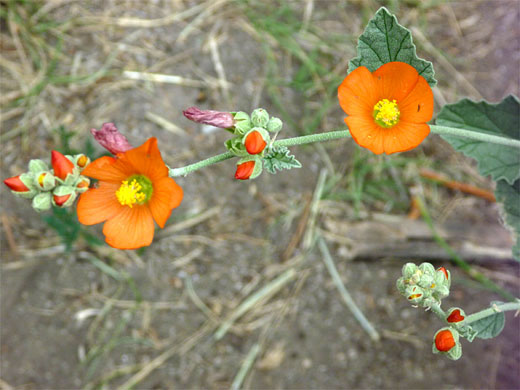Common names:
Munro's globemallow, orange globe mallow
Family:
Scientific name:
Sphaeralcea munroana
Main flower color:
Range:
The Great Basin, eastwards to northwest Colorado, and northwards to Washington
Height:
Around 30 inches
Habitat:
Open hillsides, sagebrush plains; around 6,500 feet
Leaves:
Alternate, triangular to ovate, greyish-green, with large edge teeth. About 1.5 inches long
Season:
July to September
Sphaeralcea munroana is a relatively uncommon species, found at medium elevations in the northern Great Basin Desert and adjoining areas. The leaves often provide the best means of identifying globemallows; this species has leaves that are broadly triangular, with curved bases and rounded tips, prominent veins and large, coarse teeth along the edges. Older leaves may be weakly lobed. Stems, calyces and leaves (especially the undersurfaces) are canescent, covered by very fine, white, star-shaped hairs.
Flowers form in an elongated cluster along the top few inches of the stem, attached by short pedicels (shorter than the calyces). The five petals are about half an inch long; red to orange, light green at the base, arranged around a group of pale yellow filaments topped by yellow anthers. Flowers are supported by a green calyx that opens to five lobes, fused for about half their length.
Flowers form in an elongated cluster along the top few inches of the stem, attached by short pedicels (shorter than the calyces). The five petals are about half an inch long; red to orange, light green at the base, arranged around a group of pale yellow filaments topped by yellow anthers. Flowers are supported by a green calyx that opens to five lobes, fused for about half their length.
All Contents © Copyright The American Southwest | Comments and Questions | Contribute | Site Map



